红金石型钛白粉安全技术说明书
- 格式:docx
- 大小:166.10 KB
- 文档页数:6
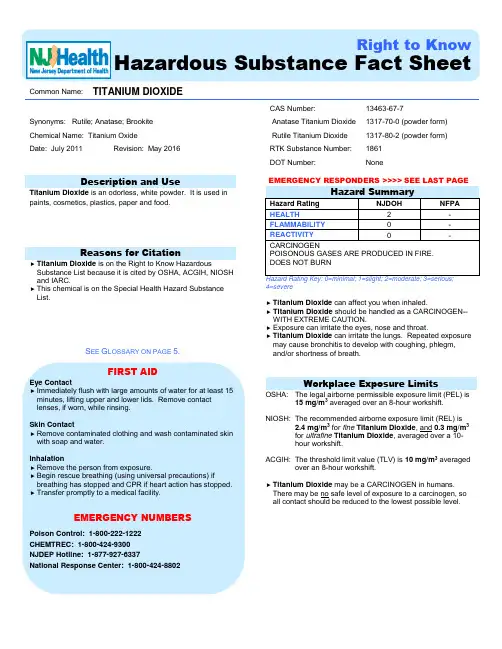
Right to Know Hazardous Substance Fact SheetCommon Name: TITANIUM DIOXIDESynonyms: Rutile; Anatase; Brookite Chemical Name: Titanium OxideDate: July 2011 Revision: May 2016 CAS Number:Anatase Titanium DioxideRutile Titanium Dioxide13463-67-71317-70-0 (powder form)1317-80-2 (powder form) RTK Substance Number: 1861DOT Number: NoneDescription and UseTitanium Dioxide is an odorless, white powder. It is used in paints, cosmetics, plastics, paper and food.Reasons for Citation④Titanium Dioxide is on the Right to Know Hazardous Substance List because it is cited by OSHA, ACGIH, NIOSH and IARC.④This chemical is on the Special Health Hazard Substance List.S EE G LOSSARY ON PAGE 5.FIRST AIDEye Contact④Immediately flush with large amounts of water for at least 15 minutes, lifting upper and lower lids. Remove contact lenses, if worn, while rinsing.Skin Contact④Remove contaminated clothing and wash contaminated skin with soap and water.Inhalation④Remove the person from exposure.④Begin rescue breathing (using universal precautions) if breathing has stopped and CPR if heart action has stopped.④Transfer promptly to a medical facility.EMERGENCY NUMBERSPoison Control: 1-800-222-1222CHEMTREC: 1-800-424-9300NJDEP Hotline: 1-877-927-6337National Response Center: 1-800-424-8802EMERGENCY RESPONDERS >>>> SEE LAST PAGEHazard SummaryHazard Rating NJDOH NFPA HEALTH 2 - FLAMMABILITY0 - REACTIVITY0 - CARCINOGENPOISONOUS GASES ARE PRODUCED IN FIRE.DOES NOT BURNHazard Rating Key: 0=minimal; 1=slight; 2=moderate; 3=serious;4=severe④Titanium Dioxide can affect you when inhaled.④Titanium Dioxide should be handled as a CARCINOGEN--WITH EXTREME CAUTION.④Exposure can irritate the eyes, nose and throat.④Titanium Dioxide can irritate the lungs. Repeated exposure may cause bronchitis to develop with coughing, phlegm,and/or shortness of breath.Workplace Exposure Limits OSHA: The legal airborne permissible exposure limit (PEL) is15 mg/m3 averaged over an 8-hour workshift.NIOSH: The recommended airborne exposure limit (REL) is2.4 mg/m3 for fine Titanium Dioxide, and 0.3 mg/m3for ultrafine Titanium Dioxide, averaged over a 10-hour workshift.ACGIH: The threshold limit value (TLV) is 10 mg/m3 averaged over an 8-hour workshift.④Titanium Dioxide may be a CARCINOGEN in humans. There may be no safe level of exposure to a carcinogen, so all contact should be reduced to the lowest possible level.Determining Your Exposure④Read the product manufacturer’s Material Safety DataSheet (MSDS) and the label to determine productingredients and important safety and health informationabout the product mixture.④For each individual hazardous ingredient, read the NewJersey Department of Health Hazardous Substance FactSheet, available on the RTK website(/health/eoh/rtkweb) or in your facility’s RTKCentral File or Hazard Communication Standard file.④You have a right to this information under the New JerseyWorker and Community Right to Know Act and the Public Employees Occupational Safety and Health (PEOSH) Act if you are a public worker in New Jersey, and under thefederal Occupational Safety and Health Act (OSHA) if you are a private worker.④The New Jersey Right to Know Act requires mostemployers to label chemicals in the workplace andrequires public employers to provide their employees with information concerning chemical hazards and controls.The federal OSHA Hazard Communication Standard (29CFR 1910.1200) and the PEOSH Hazard Communication Standard (N.J.A.C. 12:100-7) require employers to provide similar information and training to their employees.This Fact Sheet is a summary of available information regarding the health hazards that may result from exposure. Duration of exposure, concentration of the substance and other factors will affect your susceptibility to any of the potential effects described below.Health Hazard InformationAcute Health EffectsThe following acute (short-term) health effects may occur immediately or shortly after exposure to Titanium Dioxide:④Exposure can irritate the eyes, nose and throat.Chronic Health EffectsThe following chronic (long-term) health effects can occur at some time after exposure to Titanium Dioxide and can last for months or years:Cancer Hazard④Titanium Dioxide may be a CARCINOGEN in humans since it has been shown to cause lung cancer in animals.④Many scientists believe there is no safe level of exposure toa carcinogen. Such substances may also have the potential for causing reproductive damage in humans.Reproductive Hazard④According to the information presently available to the New Jersey Department of Health, Titanium Dioxide has not been tested for its ability to affect reproduction.Other Effects④Titanium Dioxide can irritate the lungs. Repeated exposure may cause bronchitis to develop with coughing, phlegm,and/or shortness of breath.MedicalMedical TestingFor frequent or potentially high exposure (half the REL or greater), the following are recommended before beginning work and at regular times after that:④Lung function testsAny evaluation should include a careful history of past and present symptoms with an exam. Medical tests that look for damage already done are not a substitute for controlling exposure.You have a legal right to request copies of your medical testing under the OSHA Access to Employee Exposure and Medical Records Standard (29 CFR 1910.1020).Mixed Exposures④Smoking can cause heart disease, lung cancer, emphysema, and other respiratory problems. It may worsen respiratory conditions caused by chemical exposure. Even if you have smoked for a long time, stopping now will reduce your risk of developing health problems.Workplace Controls and Practices Very toxic chemicals, or those that are reproductive hazards or sensitizers, require expert advice on control measures if a less toxic chemical cannot be substituted. Control measures include: (1) enclosing chemical processes for severely irritating and corrosive chemicals, (2) using local exhaust ventilation for chemicals that may be harmful with a single exposure, and (3) using general ventilation to control exposures to skin and eye irritants. For further information on workplace controls, consult the NIOSH document on Control Banding at /niosh/topics/ctrlbanding/.The following work practices are also recommended:④Label process containers.④Provide employees with hazard information and training.④Monitor airborne chemical concentrations.④Use engineering controls if concentrations exceed recommended exposure levels.④Provide eye wash fountains and emergency showers.④Wash or shower if skin comes in contact with a hazardous material.④Always wash at the end of the workshift.④Change into clean clothing if clothing becomes contaminated.④Do not take contaminated clothing home.④Get special training to wash contaminated clothing.④Do not eat, smoke, or drink in areas where chemicals are being handled, processed or stored.④Wash hands carefully before eating, smoking, drinking, applying cosmetics or using the toilet.In addition, the following may be useful or required:④Use a vacuum or a wet method to reduce dust during clean-up. DO NOT DRY SWEEP.④Use a high efficiency particulate air (HEPA) filter when vacuuming. Do not use a standard shop vacuum.Personal Protective EquipmentThe OSHA Personal Protective Equipment Standard (29 CFR 1910.132) requires employers to determine the appropriate personal protective equipment for each hazard and to train employees on how and when to use protective equipment. The following recommendations are only guidelines and may not apply to every situation.Gloves and Clothing④Avoid skin contact with Titanium Dioxide. Wear personal protective equipment made from material that can not be permeated or degraded by this substance. Safety equipment suppliers and manufacturers can provide recommendations on the most protective glove and clothing material for your operation.④The recommended glove materials for Titanium Dioxide are Nitrile, Neoprene and Natural Rubber.④The recommended protective clothing material for Titanium Dioxide is Tyvek®, or the equivalent.④All protective clothing (suits, gloves, footwear, headgear) should be clean, available each day, and put on before work. Eye Protection④Wear direct vent goggles when airborne particles or dust are present.Respiratory ProtectionImproper use of respirators is dangerous. Respirators should only be used if the employer has implemented a written program that takes into account workplace conditions, requirements for worker training, respirator fit testing, and medical exams, as described in the OSHA Respiratory Protection Standard (29 CFR 1910.134).④Where the potential exists for exposure over 2.4 mg/m3 for fine Titanium Dioxide, or 0.3 mg/m3 for ultrafine Titanium Dioxide, use a NIOSH approved supplied-air respirator with a full facepiece operated in a pressure-demand or other positive-pressure mode. For increased protection use in combination with an auxiliary self-contained breathing apparatus or an emergency escape air cylinder.Fire HazardsIf employees are expected to fight fires, they must be trained and equipped as stated in the OSHA Fire Brigades Standard (29 CFR 1910.156).④Extinguish fire using an agent suitable for type of surrounding fire. Titanium Dioxide itself does not burn.④POISONOUS GASES ARE PRODUCED IN FIRE.Spills and EmergenciesIf employees are required to clean-up spills, they must be properly trained and equipped. The OSHA Hazardous Waste Operations and Emergency Response Standard (29 CFR 1910.120) may apply.If Titanium Dioxide is spilled, take the following steps:④Evacuate personnel and secure and control entrance to the area.④Eliminate all ignition sources.④Moisten spilled material first or use a HEPA-filter vacuum for clean-up and place into sealed containers for disposal.④It may be necessary to contain and dispose of Titanium Dioxide as a HAZARDOUS WASTE. Contact your state Department of Environmental Protection (DEP) or your regional office of the federal Environmental Protection Agency (EPA) for specific recommendations.For more information, please contact: New Jersey Department of Health Right to Know PO Box 368Trenton, NJ 08625-0368 Phone: 609-984-2202 Fax: 609-984-7407E-mail:*************Web address: /health/eoh/rtkweb The Right to Know Hazardous Substance Fact Sheets are not intended to be copied and soldfor commercial purposes . Handling and StoragePrior to working with Titanium Dioxide you should be trained on its proper handling and storage.④ Titanium Dioxide powders or dusts may react violently with CHEMICALLY ACTIVE METALS (such as POTASSIUM, SODIUM, MAGNESIUM and ZINC).④ Titanium Dioxide powders or dusts are not compatible with OXIDIZING AGENTS (such as PERCHLORATES, PEROXIDES, PERMANGANATES, CHLORATES,NITRATES, CHLORINE, BROMINE and FLUORINE) and STRONG ACIDS (such as HYDROCHLORIC, SULFURIC and NITRIC).④ Store in tightly closed containers in a cool, well-ventilated area.Occupational Health InformationResourcesThe New Jersey Department of Health offers multiple services in occupational health. These services include providing informational resources, educational materials, public presentations, and industrial hygiene and medical investigations and evaluations.GLOSSARYACGIH is the American Conference of Governmental Industrial Hygienists. They publish guidelines called Threshold Limit Values (TLVs) for exposure to workplace chemicals.Acute Exposure Guideline Levels (AEGLs) are established by the EPA. They describe the risk to humans resulting from once-in-a lifetime, or rare, exposure to airborne chemicals.Boiling point is the temperature at which a substance can change its physical state from a liquid to a gas.A carcinogen is a substance that causes cancer.The CAS number is unique, identifying number, assigned by the Chemical Abstracts Service, to a specific chemical.CFR is the Code of Federal Regulations, which are the regulations of the United States government.A combustible substance is a solid, liquid or gas that will burn.A corrosive substance is a gas, liquid or solid that causes destruction of human skin or severe corrosion of containers. The critical temperature is the temperature above which a gas cannot be liquefied, regardless of the pressure applied.DEP is the New Jersey Department of Environmental Protection.DOT is the Department of Transportation, the federal agency that regulates the transportation of chemicals.EPA is the Environmental Protection Agency, the federal agency responsible for regulating environmental hazards. ERG is the Emergency Response Guidebook. It is a guide for emergency responders for transportation emergencies involving hazardous substances.Emergency Response Planning Guideline (ERPG) values provide estimates of concentration ranges where one reasonably might anticipate observing adverse effects.A fetus is an unborn human or animal.A flammable substance is a solid, liquid, vapor or gas that will ignite easily and burn rapidly.The flash point is the temperature at which a liquid or solid gives off vapor that can form a flammable mixture with air. IARC is the International Agency for Research on Cancer, a scientific group.Ionization Potential is the amount of energy needed to remove an electron from an atom or molecule. It is measured in electron volts.IRIS is the Integrated Risk Information System database on human health effects that may result from exposure to various chemicals, maintained by federal EPA. LEL or Lower Explosive Limit, is the lowest concentration of a combustible substance (gas or vapor) in the air capable of continuing an explosion.mg/m3means milligrams of a chemical in a cubic meter of air. It is a measure of concentration (weight/volume).A mutagen is a substance that causes mutations. A mutation is a change in the genetic material in a body cell. Mutations can lead to birth defects, miscarriages, or cancer.NFPA is the National Fire Protection Association. It classifies substances according to their fire and explosion hazard.NIOSH is the National Institute for Occupational Safety and Health. It tests equipment, evaluates and approves respirators, conducts studies of workplace hazards, and proposes standards to OSHA.NTP is the National Toxicology Program which tests chemicals and reviews evidence for cancer.OSHA is the federal Occupational Safety and Health Administration, which adopts and enforces health and safety standards.PEOSHA is the New Jersey Public Employees Occupational Safety and Health Act, which adopts and enforces health and safety standards in public workplaces.Permeated is the movement of chemicals through protective materials.ppm means parts of a substance per million parts of air. It is a measure of concentration by volume in air.Protective Action Criteria (PAC) are values established by the Department of Energy and are based on AEGLs and ERPGs. They are used for emergency planning of chemical release events.A reactive substance is a solid, liquid or gas that releases energy under certain conditions.STEL is a Short Term Exposure Limit which is usually a 15-minute exposure that should not be exceeded at any time during a work day.A teratogen is a substance that causes birth defects by damaging the fetus.UEL or Upper Explosive Limit is the highest concentration in air above which there is too much fuel (gas or vapor) to begin a reaction or explosion.Vapor Density is the ratio of the weight of a given volume of one gas to the weight of another (usually Air), at the same temperature and pressure.The vapor pressure is a force exerted by the vapor in equilibrium with the solid or liquid phase of the same substance. The higher the vapor pressure the higher concentration of the substance in air.Common Name: TITANIUM DIOXIDESynonyms: Rutile; Titanium Oxide; Anatase; BrookiteCAS No: 13463-67-7; 1317-70-0 (powder form); 1317-80-2 (powder form) Molecular Formula: TiO 2RTK Substance No: 1861Description: Odorless, white powderHAZARD DATA Hazard Rating Firefighting Reactivity2 - Health0 - Fire0 - ReactivityDOT#: NoneERG Guide #: None Hazard Class: None Extinguish fire using an agent suitable for type ofsurrounding fire. Titanium Dioxide itself doesnot burn.POISONOUS GASES ARE PRODUCED IN FIRE.Titanium Dioxide powders or dusts may react violentlywith CHEMICALLY ACTIVE METALS (such asPOTASSIUM, SODIUM, MAGNESIUM and ZINC).Titanium Dioxide powders or dusts are not compatiblewith OXIDIZING AGENTS (such as PERCHLORATES,PEROXIDES, PERMANGANATES, CHLORATES,NITRATES, CHLORINE, BROMINE and FLUORINE) andSTRONG ACIDS (such as HYDROCHLORIC,SULFURIC and NITRIC).SPILL/LEAKS PHYSICAL PROPERTIESIsolation Distance:Spill: 25 meters (75 feet)Fire: 800 meters (1/2 mile)Moisten spilled material first or use a HEPA-filtervacuum for clean-up and place into sealed containers for disposal. Odor Threshold:Flash Point:Vapor Pressure:Specific Gravity:Water Solubility:Boiling Point:Melting Point:Molecular Weight:OdorlessNoncombustible0 mm Hg at 68o F (20o C)3.9 to4.2 (water = 1)Insoluble4,532o to 5,432o F (2,500o to 3,000o C)3,326o to 3,362o F (1,830o to 1,850o C)79.9EXPOSURE LIMITS PROTECTIVE EQUIPMENTOSHA: 15 mg/m3, 8-hr TWANIOSH: 2.4 mg/m3 (fine) and 0.3 mg/m3 (ultrafine), 10-hr TWAACGIH: 10 mg/m3, 8-hr TWAIDLH: 5,000mg/m3The Protective Action Criteria values are:PAC-1 = 30 mg/m3 PAC-2 = 330 mg/m3PAC-3 = 2,000 mg/m3Gloves:Coveralls:Respirator:Nitrile, Neoprene and Natural RubberTyvek®Spill - Full facepiece APR with P100 filters>0.3 mg/m3 (ultrafine) or Fire – SCBA>2.4 mg/m3 (fine) or Fire - SCBA>10 mg/m3 or Fire - SCBAHEALTH EFFECTS FIRST AID AND DECONTAMINATIONEyes: Skin: Inhalation: Chronic: IrritationNo information availableNose and throat irritationCancer (lung) in animalsRemove the person from exposure.Flush eyes with large amounts of water for at least 15 minutes. Removecontact lenses if worn.Remove contaminated clothing and wash contaminated skin with soap andwater.Begin artificial respiration if breathing has stopped and CPR if necessary.Transfer promptly to a medical facility.May 2016 Right to Know Hazardous Substance Fact Sheet。
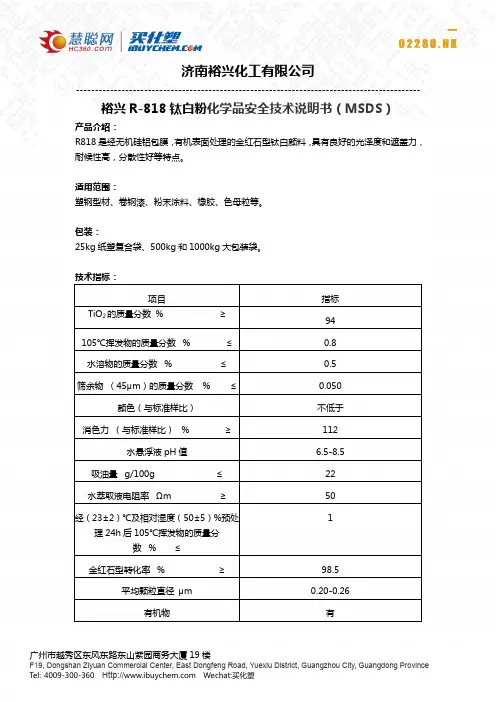
广州市越秀区东风东路东山紫园商务大厦19楼
F19, Dongshan Ziyuan Commercial Center, East Dongfeng Road, Yuexiu District, Guangzhou City, Guangdong Province
Tel: 4009-300-360 Wechat:买化塑
济南裕兴化工有限公司
裕兴R-818钛白粉化学品安全技术说明书(MSDS )
产品介绍:
R818是经无机硅铝包膜,有机表面处理的金红石型钛白颜料,具有良好的光泽度和遮盖力,耐候性高,分散性好等特点。
适用范围:
塑钢型材、卷钢漆、粉末涂料、橡胶、色母粒等。
包装:
25kg 纸塑复合袋、500kg 和1000kg 大包装袋。
技术指标:
项目
指标 TiO 2的质量分数 % ≥ 94 105℃挥发物的质量分数 % ≤ 0.8 水溶物的质量分数 % ≤ 0.5 筛余物 (45μm )的质量分数 % ≤
0.050 颜色(与标准样比)
不低于 消色力 (与标准样比) % ≥
112 水悬浮液pH 值
6.5-8.5 吸油量 g/100g ≤ 22 水萃取液电阻率 Ωm ≥ 50 经(23±2)℃及相对湿度(50±5)%预处
理24h 后105℃挥发物的质量分
数 % ≤
1
金红石型转化率 % ≥
98.5 平均颗粒直径 μm
0.20-0.26
有机物
有。
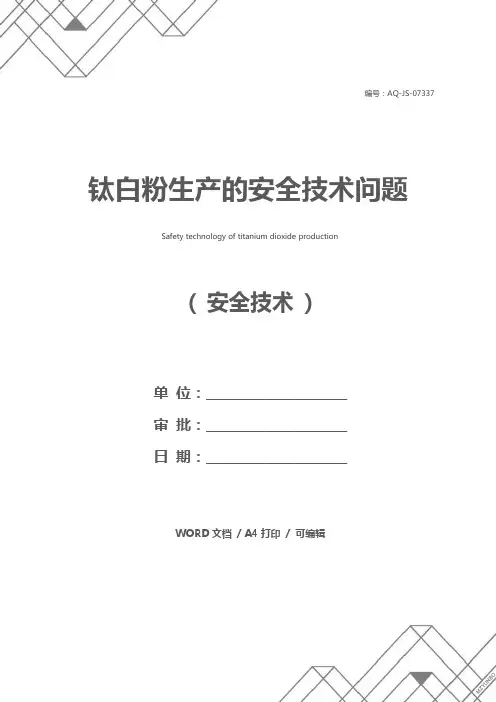
编号:AQ-JS-07337( 安全技术)单位:_____________________审批:_____________________日期:_____________________WORD文档/ A4打印/ 可编辑钛白粉生产的安全技术问题Safety technology of titanium dioxide production钛白粉生产的安全技术问题使用备注:技术安全主要是通过对技术和安全本质性的再认识以提高对技术和安全的理解,进而形成更加科学的技术安全观,并在新技术安全观指引下改进安全技术和安全措施,最终达到提高安全性的目的。
为了保障生产者的人身安全;防止事故发生,减少经济损失;我国从中央到地方,都设立了安全生产监督管理机构,钛白粉生产企业也要增强安全意识,加强安全教育,严格安全管理,落实安全措施。
1钛白粉生产中的危险化学品在钛白粉生产过程中,不安全因素较多。
本文只着重对钛白粉企业的危险化学品所带来的不安全因素进行分析。
现把各工序所使用或所产生的危险化学品名称及其CAS号(指美国化学文摘视为一种化学物质指定的唯一索引编号),UN号(指联合国货物运输专家委员会在《关于危险货物运输的建议书》中对危险货物指定的编号)、我国危险化学品编号和所属危险化学品类别列于表1。
表1钛白粉厂各工序危险化学品一览表所在工序名称分子式分子量CAS号UN号危编号所属类别硫酸法酸解浓硫酸H2SO4987664-93-91830810078.1类无机酸性腐蚀品酸解氢气H221333-74-01049210012.1类非金属易燃气体沉降硫化氢H2S34.087783-06-41053210062.1类易燃有毒气体冷冻液氨NH317.037664-41-71005230032.3类有毒气体晶种氢氧化钠(烧碱)NaOH40.011310-73-21823820018.1类无机碱性腐蚀品漂白锌粉Zn65.387440-66-61436430144.3类遇湿易燃固体漂白或铝粉Al26.987429-90-51396430134.3类遇湿易燃固体盐处理磷酸H3PO4987664-38-21805815018.1类无机酸性腐蚀品煅烧煤气CO、H2630-08-01016230232.3类易燃有毒气体煅烧或柴油碳原子数10-22 易燃易爆有毒物品氯化法氯化氯气Cl270.917782-50-51017230022.3类有毒气体精制四氧化钛TiCl4189.717550-45-01838810518.1类酸性腐蚀品2对钛白粉厂危险化学品的评价2.1火灾、爆炸的危险钛白粉厂生产中,所使用或所产生的易燃气体、易燃液体和遇湿易燃固体较多,当易燃物的蒸汽与空气混合达到爆炸极限,即可形成爆炸混合物,一旦遇明火,即会发生火灾和爆炸的危险。

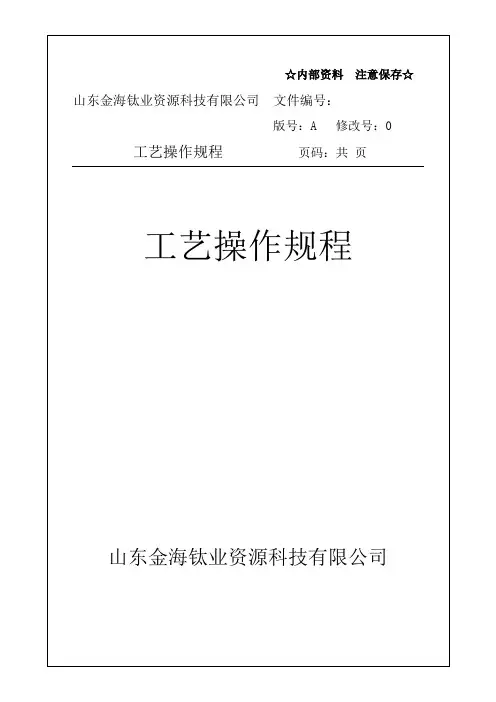
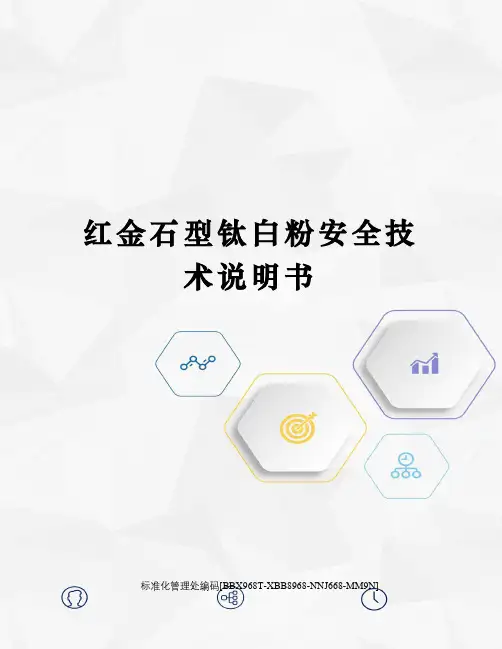
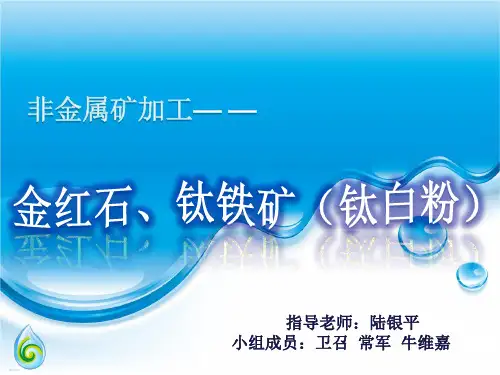
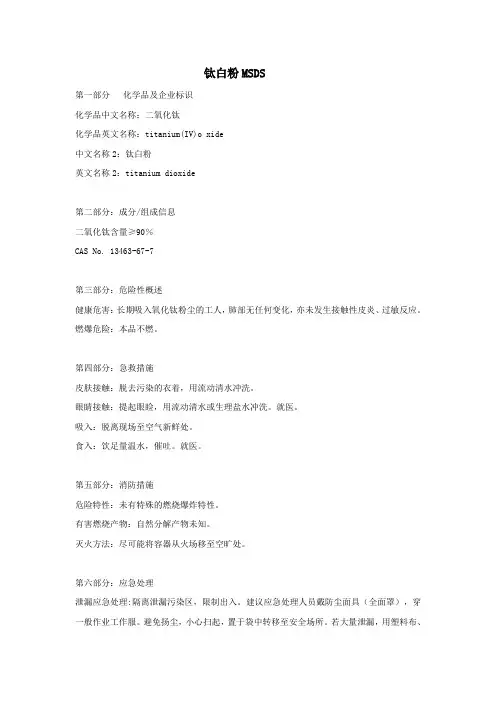
钛白粉MSDS第一部分化学品及企业标识化学品中文名称:二氧化钛化学品英文名称:titanium(IV)o xide中文名称2:钛白粉英文名称2:titanium dioxide第二部分:成分/组成信息二氧化钛含量≥90%CAS No. 13463-67-7第三部分:危险性概述健康危害:长期吸入氧化钛粉尘的工人,肺部无任何变化,亦未发生接触性皮炎、过敏反应。
燃爆危险:本品不燃。
第四部分:急救措施皮肤接触:脱去污染的衣着,用流动清水冲洗。
眼睛接触:提起眼睑,用流动清水或生理盐水冲洗。
就医。
吸入:脱离现场至空气新鲜处。
食入:饮足量温水,催吐。
就医。
第五部分:消防措施危险特性:未有特殊的燃烧爆炸特性。
有害燃烧产物:自然分解产物未知。
灭火方法:尽可能将容器从火场移至空旷处。
第六部分:应急处理泄漏应急处理:隔离泄漏污染区,限制出入。
建议应急处理人员戴防尘面具(全面罩),穿一般作业工作服。
避免扬尘,小心扫起,置于袋中转移至安全场所。
若大量泄漏,用塑料布、帆布覆盖。
收集回收或运至废物处理场所处置。
第七部分:操作处置与储存操作注意事项:密闭操作,局部排风。
操作人员必须经过专门培训,严格遵守操作规程。
建议操作人员佩戴自吸过滤式防尘口罩,戴化学安全防护眼镜,戴一般作业防护手套。
避免产生粉尘。
避免与酸类接触。
搬运时轻装轻卸,防止包装破损。
配备泄漏应急处理设备。
倒空的容器可能残留有害物。
储存注意事项:储存于阴凉、通风的库房。
远离火种、热源。
应与酸类分开存放,切忌混储。
储区应备有合适的材料收容泄漏物。
第八部分:接触控制/个体防护职业接触限值中国MAC(mg/m3):10前苏联MAC(mg/m3):10TLVTN:ACGIH 10mg/m3TLVWN:未制定标准工程控制:密闭操作,局部排风。
呼吸系统防护:空气中粉尘浓度较高时,建议佩戴自吸过滤式防尘口罩。
眼睛防护:戴化学安全防护眼镜。
身体防护:穿一般作业防护服。
手防护:戴一般作业防护手套。
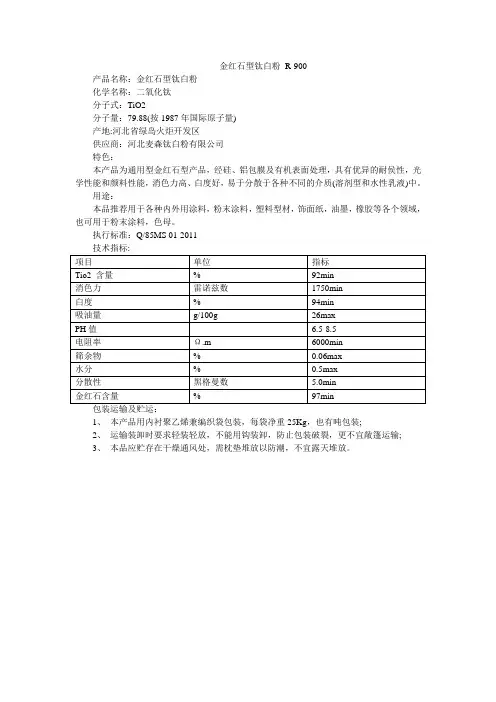
金红石型钛白粉R-900
产品名称:金红石型钛白粉
化学名称:二氧化钛
分子式:TiO2
分子量:79.88(按1987年国际原子量)
产地:河北省绿岛火炬开发区
供应商:河北麦森钛白粉有限公司
特色:
本产品为通用型金红石型产品,经硅、铝包膜及有机表面处理,具有优异的耐侯性,光学性能和颜料性能,消色力高、白度好,易于分散于各种不同的介质(溶剂型和水性乳液)中。
用途:
本品推荐用于各种内外用涂料,粉末涂料,塑料型材,饰面纸,油墨,橡胶等各个领域,也可用于粉末涂料,色母。
执行标准:Q/85MS 01-2011
技术指标:
1、本产品用内衬聚乙烯兼编织袋包装,每袋净重25Kg,也有吨包装;
2、运输装卸时要求轻装轻放,不能用钩装卸,防止包装破裂,更不宜敞篷运输;
3、本品应贮存在干燥通风处,需枕垫堆放以防潮,不宜露天堆放。
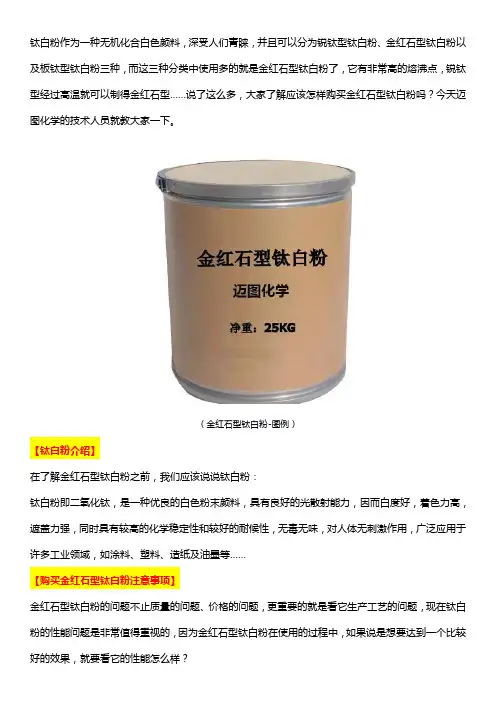
钛白粉作为一种无机化合白色颜料,深受人们青睐,并且可以分为锐钛型钛白粉、金红石型钛白粉以及板钛型钛白粉三种,而这三种分类中使用多的就是金红石型钛白粉了,它有非常高的熔沸点,锐钛型经过高温就可以制得金红石型……说了这么多,大家了解应该怎样购买金红石型钛白粉吗?今天迈图化学的技术人员就教大家一下。
(金红石型钛白粉-图例)【钛白粉介绍】在了解金红石型钛白粉之前,我们应该说说钛白粉:钛白粉即二氧化钛,是一种优良的白色粉末颜料,具有良好的光散射能力,因而白度好,着色力高,遮盖力强,同时具有较高的化学稳定性和较好的耐候性,无毒无味,对人体无刺激作用,广泛应用于许多工业领域,如涂料、塑料、造纸及油墨等……【购买金红石型钛白粉注意事项】金红石型钛白粉的问题不止质量的问题、价格的问题,更重要的就是看它生产工艺的问题,现在钛白粉的性能问题是非常值得重视的,因为金红石型钛白粉在使用的过程中,如果说是想要达到一个比较好的效果,就要看它的性能怎么样?有的企业在生产使用钛白粉的过程中会发现,一些劣质的钛白粉,在使用的过程中,它的粘合性并不是很好,或者说也在使用的过程中很难达到一个好的质量和参数,那么这就需要大家去注意:尽量去购买一些相对来说质量比较好的产品!尤其是随着我国对于钛白粉的要求不断提升,那么这就导致一些厂家在生产的过程中,可能就是会出现一些不满足国家标准的情况,那么这种不满足国家标准的产品,不管价格再低也不要购买!因为这种金红石型钛白粉价格比较低的产品,它质量完全是没有保证的,大家在购买这种产品的时候还要看一下国内生产这种金红石型钛白粉产品的厂家分布情况到底是怎么样的。
一般来说,北方生产钛白粉的厂家比较多。
北方地区对于金红石型钛白粉的需求也比较多,那么我们去选择的时候可以倾向于去选择北方地区的产品,因为北方地区的产品综合质量还是可以的。
【金红石型钛白粉用途】金红石型钛白粉有着非常广泛的用途,它在橡胶行业中既作为着色剂,又具有补强、防老化、填充作用。
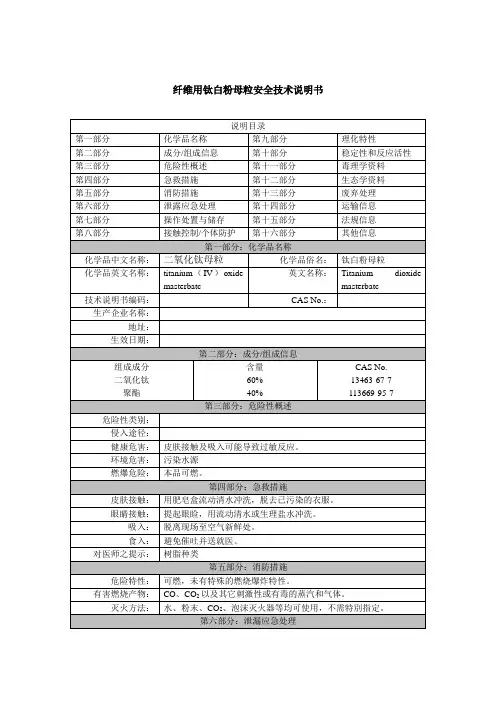
在很多的行业中,金红石型钛白粉是经常被用到的一种白色颜料,而且中国也是使用钛白粉较早的国家。
早在上世纪五十年代,钛白粉就已经开始发展起来,并且从涂料、塑料以及造纸行业逐步应用起来,而到后来这三大行业也成为了金红石型钛白粉应用前三大用户。
可是很多人并不会使用此产品,而金红石型钛白粉有一些需要注意的使用规范,我们一起来了解一下吧。
(金红石型钛白粉-图例)【金红石型钛白粉使用注意事项】现在的工业生产之中化学药品的使用现象变得越来越普遍,就像钛白粉这样的化工产品一样用处非常大,但是很多人却忽略了它对人体的危害性,比如优点人经常会有眼睛流泪、疼痛或视觉模糊的现象,有些体质敏感的人还会引起皮肤干燥或是短时间内的咳嗽等等。
但是很多人即使被伤害了还浑然不觉呢,今天我们就帮助大家来了解一下金红石型钛白粉的急救措施:一是皮肤接触,由于钛白粉对皮肤的伤害不是很大,所以只要在使用后清洗一下皮肤就会没事的;二是眼睛接触,这就需要立即用足量的水进行清洗,直到没有任何的不是感觉为止;三就是比较严重的误食了,虽然食入少量的钛白粉对人体并没有太大的伤害,但是如果有不适症状一定要抓紧时间就医。
最后希望所有的人都可以安全的使用太白粉。
【金红石型钛白粉如何使用】对于任何一种材料来说,特殊的物理性质是肯定会有的,那么在使用的时候就需要注意到这些问题,毕竟谁也不能保证在之后的使用过程中会不会使用到这些性能。
就拿金红石型钛白粉来说,其本身就具有很特殊的物理性质,那么在进行使用的时候就需要注意到这些问题。
也只有这样才能保证在今后的使用过程中,不会因为不了解金红石型钛白粉的性质而出现了偏差。
1.熔点和沸点比较高:相对来说金红石型钛白粉可以在高温下进行使用,这也说明了金红石型钛白粉的熔沸点非常高,基本上熔点可以达到1800度,而沸点只会更高。
在一定的条件下,进行工作完全没有问题。
实际上在使用金红石型钛白粉的时候最好的办法就是根据其熔沸点进行使用,在确保金红石型钛白粉在挥发之前操作才能保障其性能完全发挥出来。
金红石型钛白粉R-878技术指标抗粉化性能介绍
青岛星火大地化工有限公司前身为青岛星火化工批发有限公司,创建于1993年,于1999年正式注册为青岛星火大地化工有限公司,位于青岛市李沧区李村308国道637号,是山东地区大型化工原料经营公司。
公司拥有大型化工专业储存仓库和多个百吨级液体化工存储罐,经营品种达300多个,其中大多数品种为国内外名牌产品,并且是这些大型重点生产企业授权认证的地区总代理,目前公司经营的品种有八大系列:1、钛白粉系列2、聚乙烯醇系列3、颜料系列4、白乳胶系列5、液体化工系列6、橡胶及辅料系列7、色浆系列8、其它化工系列
其中金红石型钛白粉为主要产品系列,R878金红石型钛白粉是经无机单铝包膜,有机表面处理的金红石型钛颜料,具有良好的光泽度和遮盖力,消色力高,抗粉化,具有易在塑料及橡胶中分散等特性。
主要用于塑料、色母粒、柔性pvc、橡胶等领域。
●技术指标
项目指标
TiO2的质量分数%≥94
105℃挥发物的质量分数%≤0.8
水溶物的质量分数%≤0.5
筛余物(45μm)的质量分数%≤0.055
颜色(与标准样比)不低于
消色力(与标准样比)≥1115
水悬浮液pH值 6.0-8.5
吸油量g/100g≤20
水萃取液电阻率Ωm≥50
≤1
经(23±2)℃及相对湿度(50±5)%预处理
24h后105℃挥发物的质量分数%
金红石型转化率%≥98.5
平均颗粒直径μm0.20-0.26
有机物有。
二氧化钛
(1)化学品及企业标识
化学品中文名:二氧化钛;氧化钛;钛白;钛白粉
化学品英文名:titanium white、titanium dioxide、titanium oxide
分子式:TiO2
相对分子量:79.87
(2)成分/组成信息
成分:纯品
CAS No:12137-20-1
(3)危险性概述
(4)急救措施
(5)消防措施
(6)泄漏应急处理
(7)操作处置与储存
(8)接触控制/个体防护
(9)理化特性
外观与性状:白色无定形粉末,加热时变黄色,受高温变棕色,冷时再呈白色。
pH值:
熔点(℃):1840
沸点(℃):2900
相对密度(水=1):
相对蒸气密度(空气=1):无资料
临界压力(MPa):无意义
辛醇/水分配系数:无资料
闪点(℃):2500-3000
引燃温度(℃):无意义
爆炸下限(%): 无意义爆炸上限(%):无意义
溶解性:不溶于水。
化学性质相当稳定,不溶于盐酸、硝酸和稀硫酸。
溶于热浓硫酸、氢氟酸。
主要用途:是弱的两性氧化物,与硫酸氢钾熔融生成硫酸钛;与氢氧化钠熔融生成钛酸钠。
用作重要的白色颜料和瓷器釉药,还用于制金属钛、钛铁合金、硬质合金。
橡胶、造纸用作填料。
电机工业用于制绝缘体、电瓷等。
工业上用硫酸分解钛铁矿,除铁后再经水解制得。
(10)稳定性和反应性
稳定性:稳定。
钛白粉MSDS第一部分化学品及企业标识化学品中文名称:二氧化钛?化学品英文名称:titanium(IV)o xide中文名称2:钛白粉英文名称2:titanium dioxide第二部分:成分/组成信息二氧化钛含量≥90%CAS No. 13463-67-7第三部分:危险性概述健康危害:长期吸入氧化钛粉尘的工人,肺部无任何变化,亦未发生接触性皮炎、过敏反应。
燃爆危险:本品不燃。
第四部分:急救措施皮肤接触:脱去污染的衣着,用流动清水冲洗。
眼睛接触:提起眼睑,用流动清水或生理盐水冲洗。
就医。
吸入:脱离现场至空气新鲜处。
食入:饮足量温水,催吐。
就医。
第五部分:消防措施危险特性:未有特殊的燃烧爆炸特性。
有害燃烧产物:自然分解产物未知。
灭火方法:尽可能将容器从火场移至空旷处。
第六部分:应急处理泄漏应急处理:隔离泄漏污染区,限制出入。
建议应急处理人员戴防尘面具(全面罩),穿一般作业工作服。
避免扬尘,小心扫起,置于袋中转移至安全场所。
若大量泄漏,用塑料布、帆布覆盖。
收集回收或运至废物处理场所处置。
第七部分:操作处置与储存操作注意事项:密闭操作,局部排风。
操作人员必须经过专门培训,严格遵守操作规程。
建议操作人员佩戴自吸过滤式防尘口罩,戴化学安全防护眼镜,戴一般作业防护手套。
避免产生粉尘。
避免与酸类接触。
搬运时轻装轻卸,防止包装破损。
配备泄漏应急处理设备。
倒空的容器可能残留有害物。
储存注意事项:储存于阴凉、通风的库房。
远离火种、热源。
应与酸类分开存放,切忌混储。
储区应备有合适的材料收容泄漏物。
第八部分:接触控制/个体防护职业接触限值中国MAC(mg/m3):10前苏联MAC(mg/m3):10TLVTN:ACGIH 10mg/m3TLVWN:未制定标准工程控制:密闭操作,局部排风。
呼吸系统防护:空气中粉尘浓度较高时,建议佩戴自吸过滤式防尘口罩。
眼睛防护:戴化学安全防护眼镜。
身体防护:穿一般作业防护服。
手防护:戴一般作业防护手套。